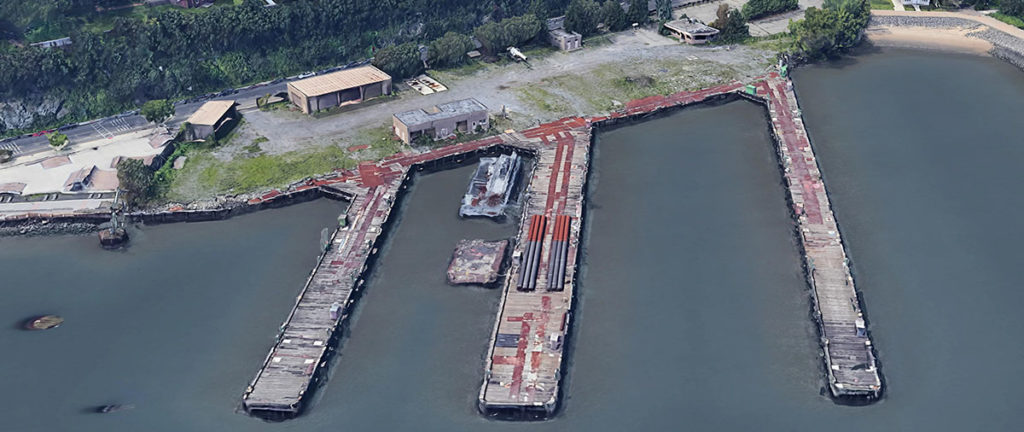Ron Hine | February 6, 2023
After a contentious, multi-year battle, the City of Hoboken now owns the former Union Dry Dock property. The next step is to develop a conceptual design for the park at this eight-acre site comprising three acres of land and five of water. In response to a request for proposals, city administrators are now sorting through submissions from various teams of landscape architects, engineers and planners and the City Council will award a contract to one of them at its Feb. 15 meeting.
Based on the Fund for a Better Waterfront’s original “1990 Plan for the Hoboken Waterfront,” combined with more than 30 years of advocacy in successful support of the creation of a continuous public park along Hoboken’s Hudson River shoreline, we urge the city to use the following criteria to guide them in designing a park at Union Dry Dock:
Public, not private: 100 percent of the Union Dry Dock site should be dedicated for the public’s use. Language in the city’s RFP suggesting “revenue-generating space” including a restaurant violates a guiding principle that we have endorsed from the beginning: The river-side of Sinatra Drive must be devoted to public park space, while commercial uses are to be located on the upland blocks designated for private development. Over the years, we have successfully defeated a succession of proposals to privatize portions of the waterfront, thus ensuring that Hoboken’s waterfront park be truly public and fully connected.
Start with trees: Multiple rows of shade trees are a unifying design element for Hoboken’s waterfront park and should be a top priority at Union Dry Dock. The benefits are many: Trees protect us from the hot summer sun; parks filled with trees and grassy areas are a place of refuge from our city streets and an opportunity to commune with nature; as these trees grow, they will play an increasingly vital role in capturing carbon dioxide and absorbing ground water. Trees require a relatively modest investment and can live for 100 years or more. Hoboken’s traditional parks built in the late 1800s are filled with trees forming generous and beautiful canopies. In the 1990s, the same was successfully done at Hoboken’s south waterfront, from Newark to Fourth streets.
Design: The award-winning landscape design for the south waterfront should serve as a model for the remainder of Hoboken’s unique shoreline. It is noteworthy for its simplicity. There are no bells and whistles. On Pier A, the structures — several kiosks and an open pavilion — are an appropriate scale for a five-acre park. All surfaces are permeable. It is a passive park available to all rather than being restricted to one type of activity. People can choose to play catch, sunbathe, picnic, join an exercise class or just hang out.
Living shorelines, habitat restoration and the piers: In the RFP, the city suggested a natural shoreline and restoration of wildlife and marine habitats. This is a logical extension of the natural beach area to the north at Maxwell Place Park and is compatible with the kayaking program that takes place there. The piers could be used for docking a barge or other vessel that would house a maritime museum or a marine education center. These kinds of ideas offer opportunities for people to get connected to the water and learn about Hoboken’s former working waterfront, as well as the diversity of life in and along the Hudson River.
Active uses: Hoboken’s linear waterfront park has become a destination for people who walk, run and cycle its length. Currently, these activities are severely constricted at Union Dry Dock. The landscape design for the park should aim to seamlessly connect the waterfront walkway, pathways and soon-to-be-built bike path, thus allowing for unobstructed circulation up and down the waterfront. A renovated and expanded skateboard park to the south will provide another important active use. A barge was retrofitted to create a unique and popular floating swimming pool in the East River now operated by the NYC Parks Department. We could do the same at one of the Dry Dock piers. FBW included the floating pool idea in its 1990 plan.
Flood resilient: Superstorm Sandy put Hoboken’s waterfront parks to the test. The trees at Pier A Park and along the south waterfront esplanade survived the storm with minimal damage. Pier C Park, however, was devastated and most of the trees at Maxwell Place Park were uprooted. At the south waterfront, the landscape architects from Arnold Associates specified 3 feet of a special soil mix throughout that allowed the trees to grow quickly and become well established with interconnecting root systems. These same planting techniques need to be employed at Union Dry Dock to ensure its resiliency and longevity.
FBW looks forward to being part of the public process the city will undertake for this project. Stakeholders will naturally lobby the city and our elected officials for many different uses, but three acres of land can only accommodate so much and might easily become over-designed and over-built. Our challenge as a community will be to strive for the right balance between active and passive space, and to integrate this significant piece of land and its piers into a coherent design for Hoboken’s entire waterfront park.
Related Links
Hoboken gains title to the Union Dry Dock property and initiates plans for a public park
After protracted delays, City takes action to expedite acquisition of Union Dry Dock site
After a contentious, multi-year battle, City will acquire Union Dry Dock
The transformation of Hoboken’s waterfront & creation of a continuous park
Making the “green circuit” greener along Hoboken’s waterfront
Construction of a long-awaited waterfront park at the Weehawken Cove
City to make offer to buy Union Dry Dock
2009 NJ Transit study identifies 5 sites more suitable for ferry facility than Union Dry Dock
Union Dry Dock: Potential Parkland for Sale
FBW’s 30-year history



